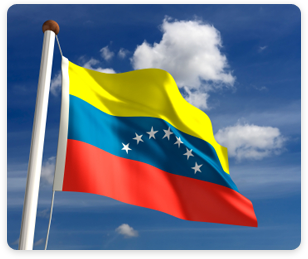Facts About Venezuela
If you’re thinking about traveling to Venezuela on vacation or business, here’s a collection of historical and fun facts about venezuela to help you understand the history of venezuela, it’s geography, Venezuela’s climate and weather, venezuela’s culture, and more…
History of Venezuela
The history of venezuela begins around 1522, when Venezuela was first colonized by Spain, and then later became the first Spanish American colony to declare independence in 1811.
During the 19th century, Venezuela went through a period of political drama, and was dominated by military strongmen up until the 20th century.
Venezuela first saw democratic rule from 1945 – 1948, and has been democratic since then.
Venezuela suffered through a long economic crises in the 1980s and 1990s that led to political instability that sparked riots that left hundreds dead in Caracazo in 1989.
In 1998, Hugo Chavez was elected and launched the Bolivarian Revolution. A Constituent Assembly was created to write the 26th (and current) Constitution of Venezuela. Venezuela’s newest Constitution replaced the last one written in 1961.
Geography of Venezuela
Venezuela, officially called the Bolivarian Republic of Venezuela, is a country on South America’s northern coast that’s home to approximately 29 million people.
Venezuela shares a border with Columbia to the west, Guyana to the east, and Brazil to the south.
Venezuela’s northern coastline stretches approximately 2,800 kilometers that share the waters with numerous islands in the Caribbean sea, including Los Roques, Venezuela.
Venezuela covers approximately 916,445 square kilimoeters (353,841 square miles).
The country of Venezuela consists of 23 states: the Capital District (Caracas) and Federal Dependencies that also cover Venezuela’s islands.
States of Venezuela
The country of Venezuela is divided into 23 states (estados in Spanish). Below is a complete list of Venezuela’s states:
- Amazonas
- Anzoátegui
- Apure
- Aragua
- Barinas
- Bolivar
- Carabobo
- Cojedes
- Delta Amacuro
- Falcón
- Guárico
- Lara
- Mérida
- Miranda
- Monagas
- Nueva Esparta
- Portuguesa
- Sucre
- Táchira
- Trujillo
- Vargas
- Yaracuy
- Zulia
Venezuela Climate and Weather
The weather in Venezuela varies quite a bit, despite it’s relatively small size (Venezuela is about twice the size of the state of California in the USA.) Venezuela’s climate ranges from humid, low elevation plains where the average annual temperature is approximately 82° Fahrenheit (28° Celsius) to very cold glaciers and highlands with an average temperature of about 46° Fahrenheit (8° Celsius).
Venezuela climates are classified as: tropical, dry, temperate with dry winters, and polar that change with the elevation throughout the country.
Venezuela Culture
Historically, Venezuela’s culture has been influenced by indigenous, Spanish (Caribbean), and African influences that you can see in it’s art, music, and architecture.
Art of Venezuela
Early on, Venezuela’s Art was dominated by religious themes. During the 19th century, a movement led by Martin Tovar shifted the focus of Venezuelan art to historical and heroic figures. Modernism became a popular art form in Venezuela with the changes in Western society that began during the late 19th century and continued into the 20th century.
Music of Venezuela
Venezuela’s music scene is diverse, and ranges from traditional genres to western-style pop & rock. One of the most popular music genres in Venezuela is joropo – a musical style that originated in the plains (llanos in Spanish) regions of the country, made popular by artists like Juan Vicente Torrealba, Ignacio Figueredo, and others. Venezuela’s Zulia state, is the home of another popular style of music, gaita, which is especially popular during Christmas.
In other areas of Venezuela, you’ll also find people listening to galeron, malaguena, and punto genres of music. Venezuela is also influenced by Cuban-American salsa, as well as American style pop and rock music.
The National Musical Instrument of Venezuela is the cuatro. The cuatro is similar to a guitar, but smaller in size. The cuatro is found throughout South America, and the West Indies, and is commonly found in use in Colombia, Jamaica, and Mexico, Puerto Rico, and other countries. Cuatro means “four” in Spanish, but you might see a cuatro with more than four strings.
Why Travel to Venezuela
People that want to travel to Venezuela often search the Internet and think back to articles they’ve read about the country. When you read newspapers articles about Venezuela, it’s common to hear about Venezuela’s oil production, or controversial political statements by President Hugo Chavez, but there’s so much more to Venezuela to enjoy, see and explore! It is in Venezuela that you’ll find the world’s highest waterfall, Angel Falls (Salto Ángel in Spanish) where water drops over 3,211 feet (979 meters).
Venezuela’s northern coastline along the Caribbean is the longest stretch of Caribbean coastline of any country. If being on a beautiful caribbean beach is your style, head to the Northern coast of Venezuela to enjoy a relaxing day on the sand overlooking clear blue sea, or go scuba diving, bonefishing, scuba diving, kite surfing, wind surfing, paragliding and other recreational activities.
Looking for an exciting nightlife? Head to Venezuela’s capital, Caracas and party it up in a salsa or rock night club. Or take it easy in Caracas and travel to a regional festival, shop for beautiful arts and crafts, or take in a baseball game at the local stadium.







